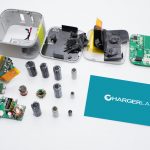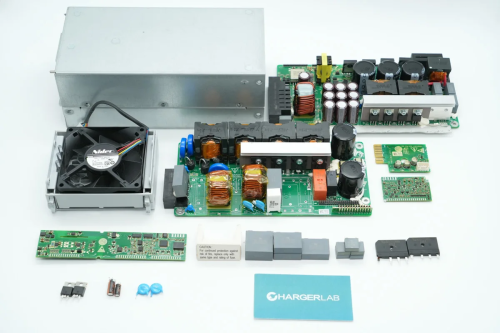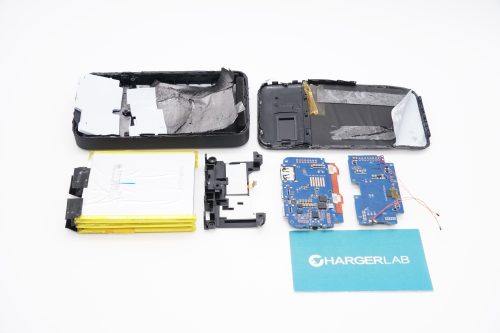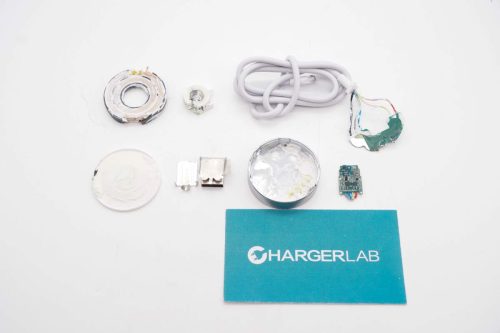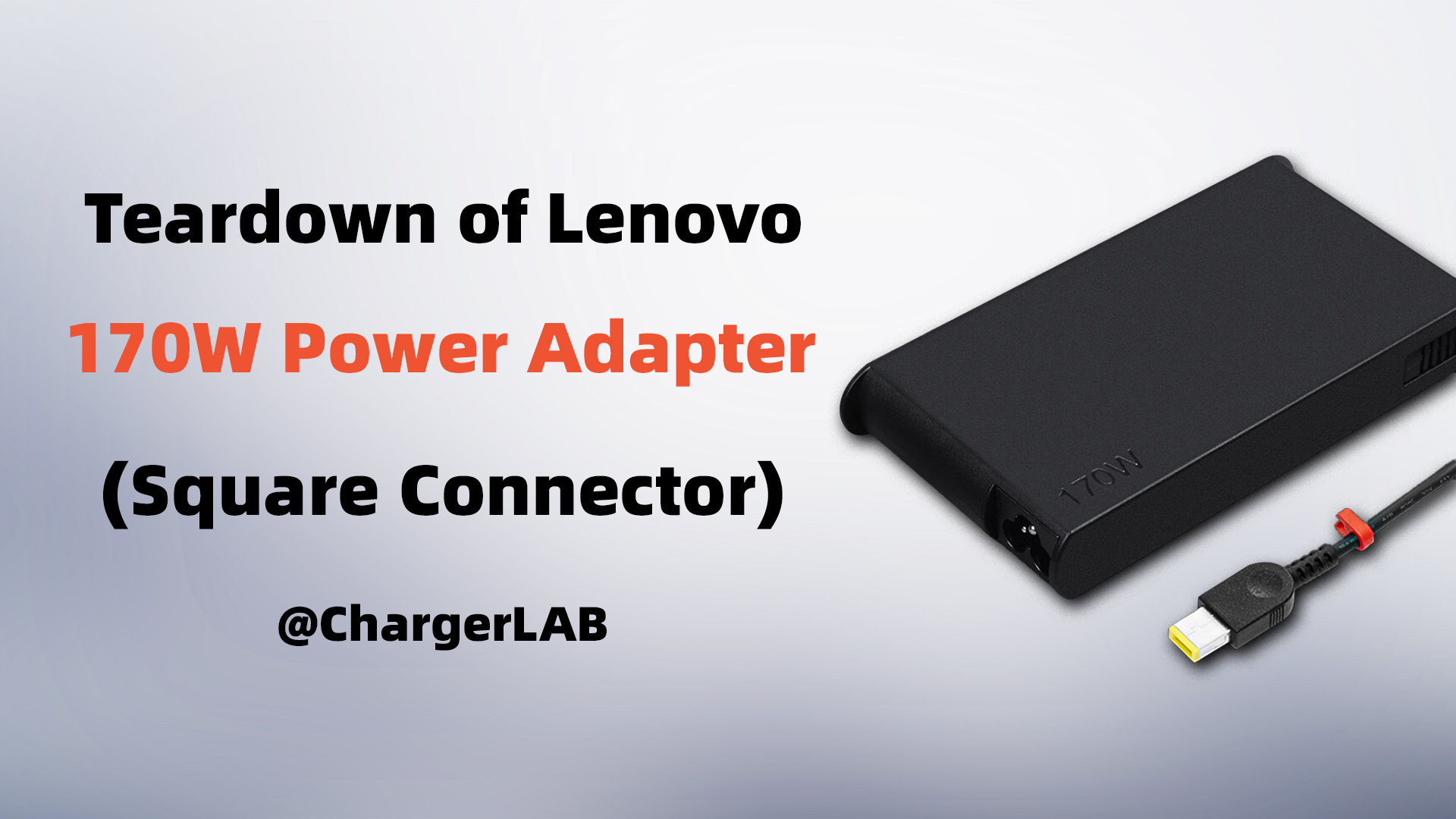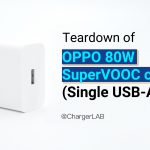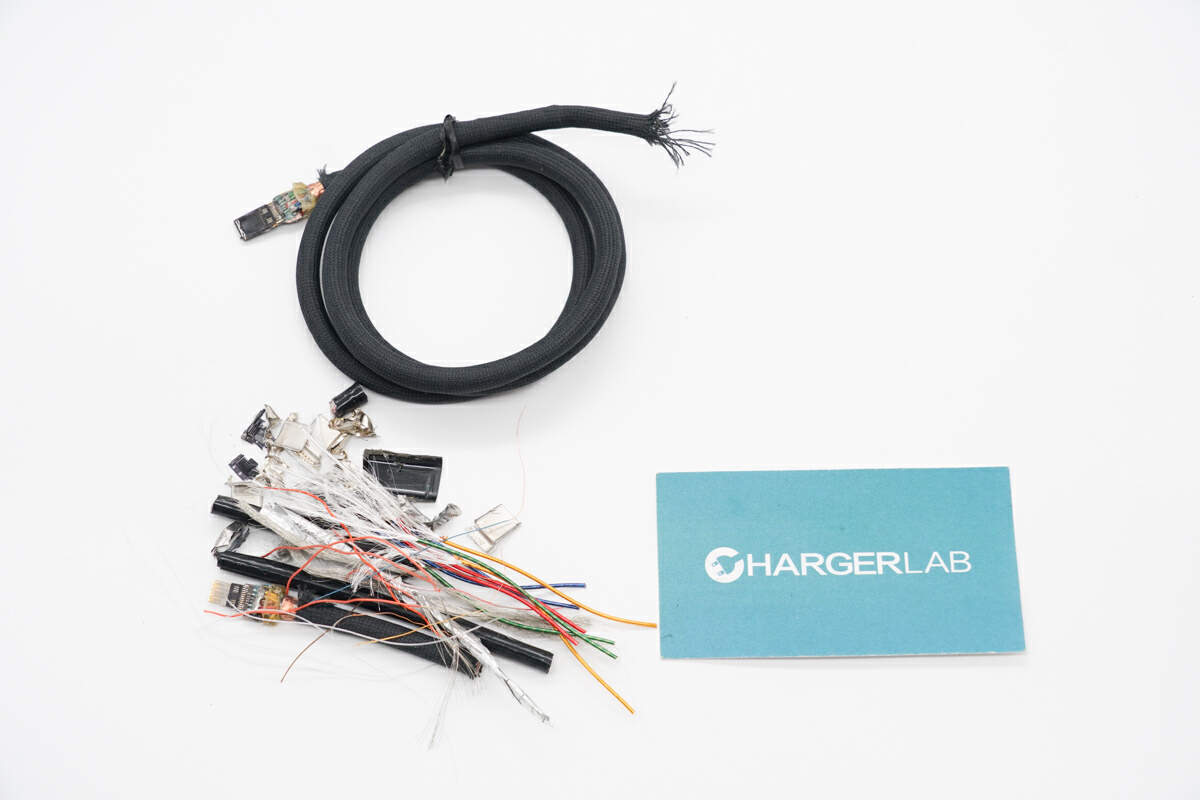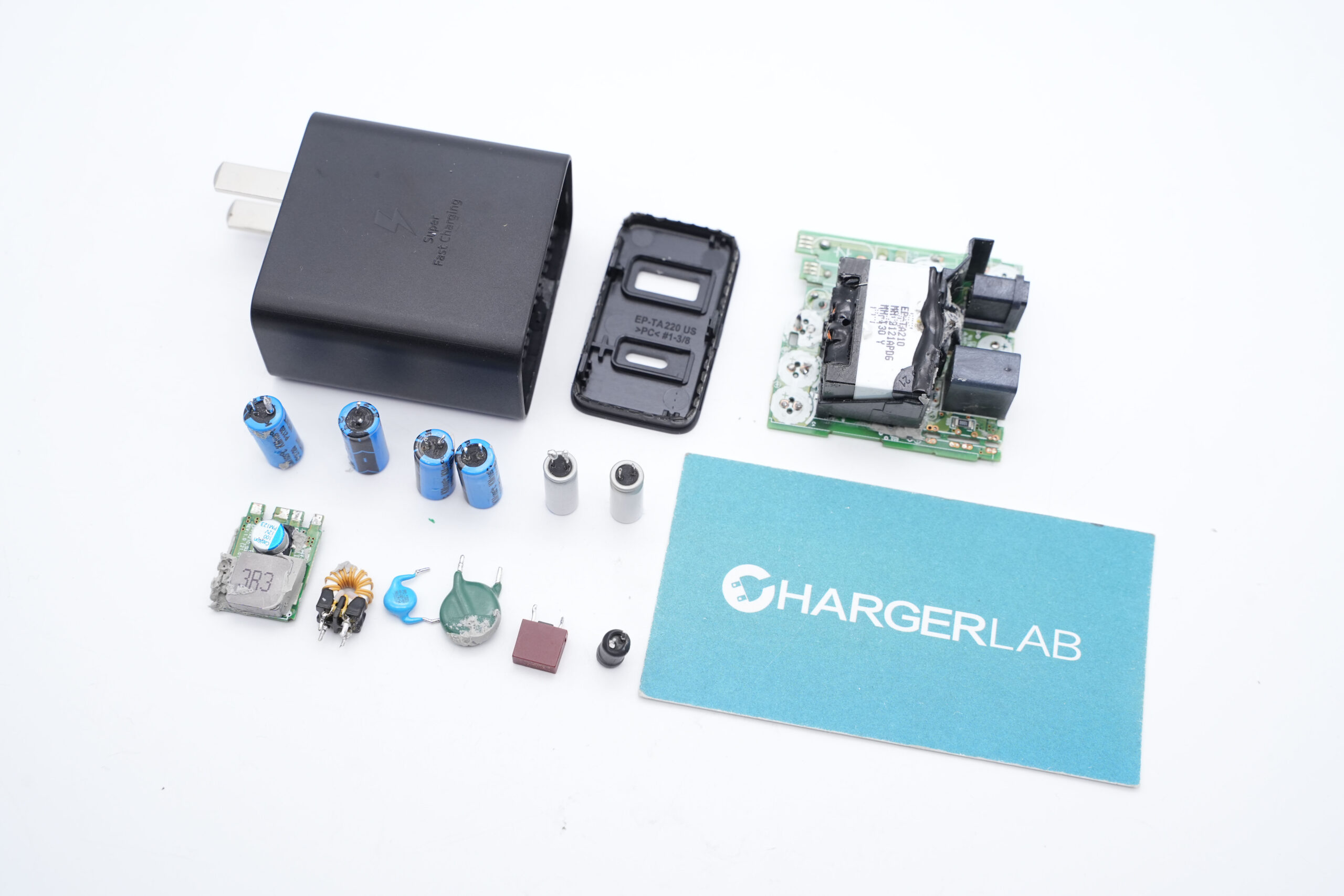Harman/Kardon is a department of Harman International Industries. Recently, ChargerLAB got an InfinityLAB 65W GaN charger, which is very compact. Because it integrates GAN FET from GaN Systems. Moreover, it has dual output ports (USB-A and USB-C). So, you can charge two devices at the same time and save your time.
If you haven’t heard about GaN Systems, you can click here to view the teardown of Brand New Apple 140W USB-C GaN Charger. It’s the first PD3.1 charger equipped with two GAN FETs from GaN Systems, which shows the high-quality and high-performance chips from GaN Systems.
Then, ChargerLAB will take it apart to see what’s inside.
1. Appearance

The brand name-InfinityLAB and product are printed on the front.

Turn to back. We can see the specs and other info.

Open the box. It contains a charger and three different plugs.

They’re the US, EU, and UK plug, respectively.

The charger adopts the rounded rectangle design, with a yellow bar on the top.

We can see “65” on the front of the charger, indicating that this charger can support 65W.

The input adopts 2-prong (figure 8) interface. And the brand name “InfinityLAB” is printed on the yellow bar.

Here are the specs of this charger.
Model is ILINC 65W. It supports 100-240V~50/60HZ 1.5A.
And the output of USB-A is 5V3A, 15W. Output of USB-C is 5V3A, 9V3A, 12V3A, 15V3A, 20V3.25A. The maximum output power is 65W.
It also has passed lots of certifications, such as EAC, UKCA, TUV, CE, SAFETY MARK.

It is equipped with an LED indicator, one USB-A, and one USB-C at the output.

The length of the charger is 56.09mm (2.21 inches).

The width is 56.03mm (2.21 inches).

The thickness is 28.92mm (1.14 inches).
So the size of this charger is 90.89cm³, and the power density is 0.72W/cm³.

Compared with Apple 61W charger, the size difference is obvious.

This is how it looks like when you hold it.

The weight is about 118g (4.16 oz).

The indicator light is white after plugging it in.

Using ChargerLAB POWER-Z KT002 to test it.
The USB-C supports Apple 2.4A, Samsung 5V2A, DCP protocol, and PD3.0 fast charging protocols.

The USB-C also has five fixed PDOs of 5V3A, 9V3A, 12V3A, 15V3A, and 20V3.25A.

And the USB-A only supports the Apple 2.4A protocol.
2. Teardown

After opening the shell, we can see the insulating plate is pasted on the shell.
And there’re lots of black thermal adhesives inside for heat dissipation.

The input plug connects to PCB through the red and black wires.

The length of the PCB module is 50.86mm (2 inches).

The width is 48.52mm (1.91 inches).

The thickness is 22.81mm (0.9 inches).

Here is the front of the PCB. We can see all the plug-in components.

And this is the back of the PCB.
The master control chip and the GaN FET from GaN Systems are on the right. And two bridge rectifiers, optocoupler, SMD Y capacitor are on the left.
We found it adopts the high-frequency QR topology. The protocol chip can control the USB-C output voltage, and the USB-A will output at a constant 5V after the secondary step-down.
Next, we will start from the input to analyze every single component.

Here is a small PCB, which is equipped with an SMD fuse. And the electrolytic capacitor for high-voltage filtering is wrapped with insulating tape.

Turn to another side. There are three electrolytic capacitors for high-voltage filtering.

Remove the small PCB. There is common mode choke, varistor, and safety X capacitor.

The rated current of the SMD fuse is 3.15A.

And the common mode choke is wound by double-wire to filter out EMI interference.

The 10D511K varistor comes from STE Electronics, used for input overvoltage protection.

The safety X capacitor comes from WQC Electronics.

Two bridge rectifiers from Chongqing Pingwei TMBFR310 are used to dissipate heat evenly.

Close-up of I-shaped inductor.

There are five primary electrolytic capacitors for high-voltage filtering, four of which are from Acon, 400V 22μF.

The fifth one comes from Fujicon Electric, 400V 33μF.
It has more than 30 years of designing, manufacturing, and supplying aluminum electrolytic capacitors.

Turn to another side. We can see the power supply capacitor of master control chip, transformer, and solid capacitors for output filtering.

This is the capacitor of the master control chip, and the spec is 25V 22μF.

The master control chip comes from ON Semiconductor NCP1342, which is a highly integrated quasi−resonant flyback controller with active X2 capacitor discharge feature and has complete protection functions.

The GaN FET comes from GaN Systems, model is GS-065-011-1-L. It is an enhancement mode GaN-on-Silicon power transistor. It allows for high current, high voltage breakdown, and high switching frequency. So, it’s very suitable for small size and high-power products.

Datasheet of GaN Systems GS-065-011-1-L.

The transformer is soldered on the small PCB. And the small PCB is equipped with and an RCD snubber circuit.

This is a 1009 optocoupler, used for communication and output voltage feedback.

The SMD Y capacitor comes from TRX Technology. It’s small and light, suitable for high-density power products, like GaN fast chargers.

Close-up of another SMD Y capacitor from TRX.

The secondary synchronous rectification controller is marked with IAZEM. Model is MPS MP6908.
It supports wide-voltage output and multiple operation modes, such as DCM, CCM, and quasi-resonant. It also supports the synchronous rectification of the high-side and low-side.

The synchronous rectifier comes from Hunteck HGN050N10AL, which adopts DFN 5x6 package. Withstand voltage is 100V.

This is the filter inductor.

The spec of solid capacitor for output filtering is 25V 680μF, and it comes from Yiyang JSH.

Another solid capacitor for output filtering is 25V 100μF.

This is the small output PCB. And there’re USB receptacles, protocol chip, step-down inductor, filter capacitors, thermistor, and other components on it. The inductor and thermistor are reinforced by glue.

Remove the small PCB. There’s a layer of insulation tape on the other side.

The protocol chip of USB-C comes from Weltrend WT6636F, which has passed the USB PD3.0 (PPS) certification of the USB-IF Association, TID: 1080018. It also has passed the Qualcomm QC4+ certification. The certification number is QC20200316138.
This protocol chip can support USB PD3.0, line loss compensation, and multiple protection functions. It integrates shunt regulator, low side current sense amplifier, 10-bit ADC for voltage and current monitoring, 8051 compatible MCU, and discharge MOS transistor.

The output VBUS switch MOSFET comes from ARKmicro AKF30N5P0S. It adopts PDFN3333 package and withstand voltage is 30V.

This is the USB-C receptacle.

The step-down inductor is reinforced by silicone adhesives.

There’s a step-down controller under the step-down inductor. Model is DXN EUP3271. It adopts the SOP-8 (EP) package and is used for the 5V output of USB-A.
It’s a synchronous step-down DC-DC converter under constant voltage/constant current mode, which can support wide-range input voltage of 4.5-36V and up to 4A output.

This is an automatic identification chip of USB-A, marked with T24EaFA.

And this is the 321 single op amp, used to detect the current of the USB-A and control the power distribution of USB-C.

The spec of solid capacitor for output step-down is 6.3V 150μF.

This is the thermistor that detects the internal temperature of the charger.

Finally, here is the USB-A receptacle.

OK, that’s all for the teardown of Harman Kardon InfinityLAB 65W GaN charger. Let’s take a “family portrait.”
Summary of ChargerLAB
The reason why this charger can be so small is because of the GaN FET by GaN Systems. And it also has an excellent performance in terms of efficiency and temperature.
We found this charger adopts ON Semiconductor NCP1342 and MPS MP6908. It is also equipped with GaN Systems GaN FET and Hunteck synchronous rectifier.
The protocol chip of Weltrend WT6636F can control the output voltage of USB-C, and the USB-A will output at a constant 5V after the secondary step-down.
And the plugs are detachable, which makes the product more portable and can be easily replaced with the US / UK / Europe plug. So, it’s more suitable for the businessman who travels a lot.

